Midea Kitchen Appliances XM059KYY Microwave Oven User Manual VG8XM059KYY
Guangdong Midea Kitchen Appliances Manufacturing Co.,Ltd Microwave Oven VG8XM059KYY
Contents
- 1. User manual
- 2. VG8XM059KYY_User Manual
VG8XM059KYY_User Manual

SAVE THESE INSTRUCTIONS CAREFULLY
Read these instructions carefully before using your
microwave oven,and keep it carefully.
If you follow the instructions, your oven will provide you with
many years of good service.
Model: EM059K9X
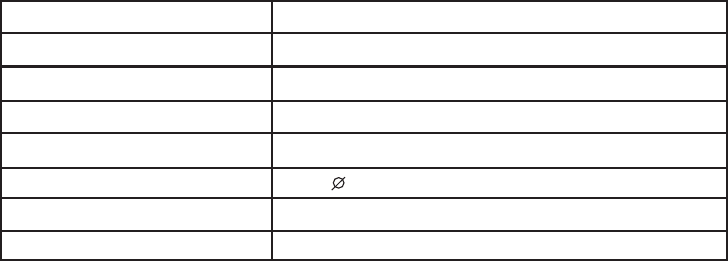
PRECAUTIONS TO AVOID POSSIBLE
EXPOSURE TO EXCESSIVE MICROWAVE
ENERGY
(a) Do not attempt to operate this oven with the door open since
operation can result in harmful exposure to microwave energy.
It is important not to defeat or tamper with the safety interlocks.
(b) Do not place any object between the oven front face and the door or allows soil or
cleaner residue to accumulate on sealing surfaces.
(c) Do not operate the oven if it is damaged. It is particular important that
the oven door close properly and that there is no damage to the:
(1) DOOR (bent)
(2) HINGES AND LATCHES (broken or loosened)
(3) DOOR SEALS AND SEALING SURFACE
(d) The oven should not be adjusted or repaired by anyone except properly
qualified service personnel.
open-door
S
ly
Specifications
Model:
Rated Voltage:
Rated Input Power(Microwave):
Rated Output Power(Microwave):
Oven Capacity:
Turntable Diameter:
External Dimensions:
Net Weight:
EM059K9
Approx. kg
120V~60Hz
1000W
1550W
59L
2
360mm
759x409x446mm
28.2
X
WARNING -
1. Read all instructions before using the
appliance.
2. Read and follow the specific:
EXCESSIVE MICROWAVE ENERGY"
found on page 2.
combustible materials are placed inside the oven to facilitate cooking.
only to properly grounded outlet. See
found on
page 5.
accordance with the provided installation
instructions.
To reduce the risk of burns, electric shock, fire, injury to persons or exposure
to excessive microwave energy:
3. This appliance must be grounded. Connect
"PRECAUTIONS TO AVOID POSSIBLE EXPOSURE TO
"GROUNDING INSTRUCTIONS"
4. Install or locate this appliance only in
5. Some products such as whole eggs and sealed containers - for example, closed glass
jars - are able to explode and should not be heated in this oven.
6. Use this appliance only for its intended use as described in the manual. Do not use
corrosive chemicals or vapors in this appliance. This type of oven is specifically
designed to heat, cook or dry food. It is not designed for industrial or laboratory use.
supervision is necessary when used
by children.
7. As with any appliance, close
damaged cord or plug, if it is not
working
properly, or if it has been
damaged or dropped.
8. Do not operate this appliance if it has a
by qualified service personnel.
Contact nearest
authorized service
facility for examination, repair, or
adjustment.
9. This appliance should be serviced only
10. Do not cover or block any openings on the appliance.
11. Do not store this appliance outdoors. Do not use this product near water - for
example,
near a kitchen sink, in a wet
basement, near a swimming pool, or
similar location.
1 . Do not immerse cord or plug in water.2
1 . Keep cord away from heated surface.
14. Do not let cord hang over edge of
table or counter.
3
15. When cleaning surfaces of door and oven that comes together on closing the door,
16. To reduce the risk of fire in the oven cavity:
1). Do not overcook food. Carefully attend appliance when paper, plastic, or other
2). Remove wire twist-ties from paper or plastic bag before placing bag in oven.
3). If material inside of the oven ignite, keep oven door closed, turn oven off, and
disconnect the power cord, shut off power at the fuse or circuit breaker panel.
4). Do not use the cavity for storage purposes. Do not leave paper products, cooking
utensils, or food in the cavity when not in use.
point without appearing to be boiling. Visible bubbling or boiling when the container is
removed from the microwave oven is not always present.
17. Liquids, such as water, coffee, or tea are able to be overheated beyond the boiling
IMPORTANT SAFETY INSTRUCTIONS
precautions should be followed, including
When using electrical appliances basic safety
following:the
use only mild, nonabrasive soaps, or detergent applied with a sponge or soft cloth.
or
3
stand in the microwave oven for a short time
before removing the container. spoon or other utensil into the container.
GROUNDING INSTRUCTIONS
THIS COULD RESULT IN VERY HOT LIQUID SUDDENLY BOILING OVER WHEN
To reduce the risk of injury to persons:
1) Do not overheat the liquid.
2) Stir the liquid both before and halfway through heating it.
3) Do not use straight-sided containers with narrow necks.
4) After heating, allow the container to
5) Use extreme care when inserting a
WARNING - Improper use of the grounding can result in a risk of electric shock.
Consult a qualified electrician or serviceman if the grounding instructions are not
completely or if doubt exists as to whether the appliance is properly grounded.
extension cord, use only a 3-wire extension cord that has a
The marked rating of the extension cord shall be equal to or greater than the electrical
appliance.
understood,
If it is necessary to use an
3-blade grounded plug, and 3-slot receptacle that will accept the plug on the appliance.
rating of the
Electric Shock Hazard
Touching some of the internal components can cause serious personal injury or death.
disassemble this appliance.
DANGER -
Do not
Electric Shock Hazard
Improper use of the grounding can result in electric shock. Do not plug into an outlet until
appliance is properly installed and grounded.
WARNING -
1. A short power-supply cord is provided to reduce the risks resulting from becoming
entangled in or tripping over a longer cord.
2. Longer cord sets or extension cords are available and may be used if care is exercised
in their use.
SA E THESE INSTRUCTIONS
18. As with any appliance, close supervision is necessary when the microwave oven is
used by children.
19. If material inside of the oven should ignite, the oven door should be kept closed, the
appliance turned off, the power cord disconnected, or the power shut off at the fuse
or circuit breaker panel.
THE CONTAINER IS DISTURBED OR A UTENSIL IS INSERTED INTO THE LIQUID.
This appliance must be grounded. In the event of an electrical short circuit, grounding
of electric shock by providing an escape wire for the
appliance is equipped with a cord having a
plugged into an outlet that is properly installed and grounded.
grounding wire with a grounding plug.
reduces the risk electric current. This
The plug
must be
V
4
1. Operation of the microwave oven may cause interference to your radio, TV
or similar
2. When there is interference, it may be reduced or eliminated by taking the
following
1) Clean door and sealing surface of the oven
2) Reorient the receiving antenna of radio or television.
3) Relocate the microwave oven with respect to the receiver.
4) Move the microwave oven away from the receiver.
5) Plug the microwave oven into a different outlet so that microwave oven
are on different branch circuits.
RADIO INTERFERENCE
equipment.
measures:
and receiver
3. If a long cord or extension cord is used:
1) The marked electrical rating of the cord set or extension cord should be at least as
great as the electrical rating of the appliance.
2) The extension cord must be a grounding-type 3-wire cord.
3) The longer cord should be arranged so that it will not drape over the counter top or
tabletop where it can be pulled on by children or tripped over unintentionally.
SAFETY
1. The oven must be on a leveled surface.
2. The turntable and turntable roller rest must be in the oven during cooking. Place the
cookware gently on the turntable and handle it carefully to avoid possible breakage.
3. Incorrect use of browning dish may cause the turntable to break.
4. Use only the specified bag size when using Direct Access Popcorn.
5. The oven has several built-in safety switches to ensure that the power remains off when
the door is open. Do not tamper with these switches.
6. Do not operate the microwave oven empty. Operating the oven with no food or food that
is extremely low in moisture can cause fire, charring or sparking.
7. Do not cook bacon directly on the turntable. Excessive local heating of the turntable
may cause the turntable to break.
8. Do not heat baby bottles or baby food in the microwave oven. Uneven heating
may occur and could cause physical injury.
5
9. Do not heat narrow-necked containers, such as syrup bottles.
10. Do not attempt to deep-fry in your microwave oven.
1
1. Do not attempt home canning in this microwave oven, as it is impossible to be sure
all contents of the jar have reached boiling temperature.
12. Do not use this microwave oven for commercial purpose. This microwave oven is made
for household use only.
13. To prevent delayed eruptive boiling of hot liquids and beverages or scalding yourself,
stir liquid before placing the container in the oven and again halfway through cooking
time. Let stand in the oven for a short time and stir again before removing the container.
14. Use carefully when cooking food in the microwave oven to avoid burning due to
excessive cooking.
15. When the appliance is operated in the combination mode, children should only use the
oven under adult supervision due to the temperatures generated.
16. Failure to maintain the oven in a clean condition could lead to deterioration that could
adversely affect the life of the appliance and possibly result in a hazardous situation.
Personal Injury Hazard
Tightly-closed utensils could explode. Closed containers should be opened and plastic
pierced before cooking.
Utensil Test:
1. Fill a microwave-safe container with 1 cup of cold
water (250ml) along with the
2. Cook on maximum power for 1 minute.
3. Carefully feel the utensil. If the empty utensil is
warm, do not use it for microwave
4. Do not exceed 1 minute cooking time.
UTENSILS
See the instructions on "Materials you can use in microwave oven or to be avoided in
There may be certain non-metallic utensils that are not safe to use for microwaving. If
utensil in question following the procedure below.
CAUTION -
pouches should be
microwave oven."
in doubt, you can test the
utensil in question.
cooking.
6
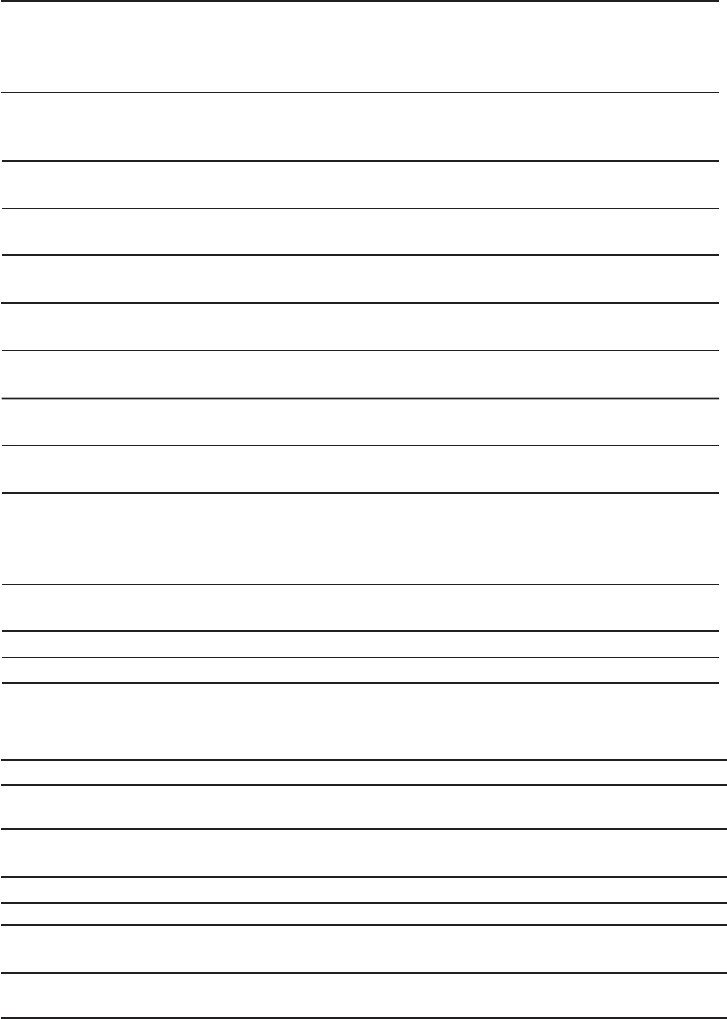
Materials you can use in microwave oven
Utensils Remarks
Aluminum foil Shielding only. Small smooth pieces can be used to cover thin parts of
meat or poultry to prevent overcooking. Arcing can occur if foil is too
close to oven walls. The foil should be at least 1 inch (2.5cm) away from
oven walls.
Follow manufacturer* instructions. The bottom of browning dish must be
at least 3/16 inch (5mm) above the turntable. Incorrect usage may cause
the turntable to break.
Microwave-safe only. Follow manufacturer's instructions. Do not use
cracked or chipped dishes.
Always remove lid. Use only to heat food until just warm. Most glass jars
are not heat resistant and may break.
Heat-resistant oven glassware only. Make sure there is no metallic trim.
Do not use cracked or chipped dishes.
Follow manufacturer* instructions. Do not close with metal tie. Make
slits to allow steam to escape.
Use for short*erm cooking/warming only. Do not leave oven unattended
while cooking.
Use to cover food for reheating and absorbing fat. Use with supervision
for a short-term cooking only.
Use as a cover to prevent splattering or a wrap for steaming.
Microwave-safe only. Follow the manufacturer* instructions. Should be
labeled "Microwave Safe". Some plastic containers soften, as the food
inside gets hot. "Boiling bags" and tightly closed plastic bags should be
slit, pierced or vented as directed by package.
Microwave-safe only. Use to cover food during cooking to retain
moisture. Do not allow plastic wrap to touch food.
Thermometers Microwave-safe only (meat and candy thermometers).
Wax paper Use as a cover to prevent splattering and retain moisture.
Browning dish
Glass jars
Glassware
Oven cooking
bags
Paper plates
and cups
Paper towels
Parchment
paper
Plastic
Plastic wrap
Dinnerware
Materials to be avoided in microwave oven
Utensils Remarks
Aluminum tray
Food carton with
metal handle
Metal or metal-
trimmed utensils
Metal twist ties
Paper bags
Plastic foam
Wood
Metal shields the food from microwave energy. Metal trim may
cause arcing.
May cause a fire in the oven.
Plastic foam may melt or contaminate the liquid inside when exposed
to high temperature.
Wood will dry out when used in the microwave oven and may split
or crack.
May cause arcing. Transfer food into microwave-safe dish.
May cause arcing. Transfer food into microwave-safe dish.
May cause arcing and could cause a fire in the oven.
7
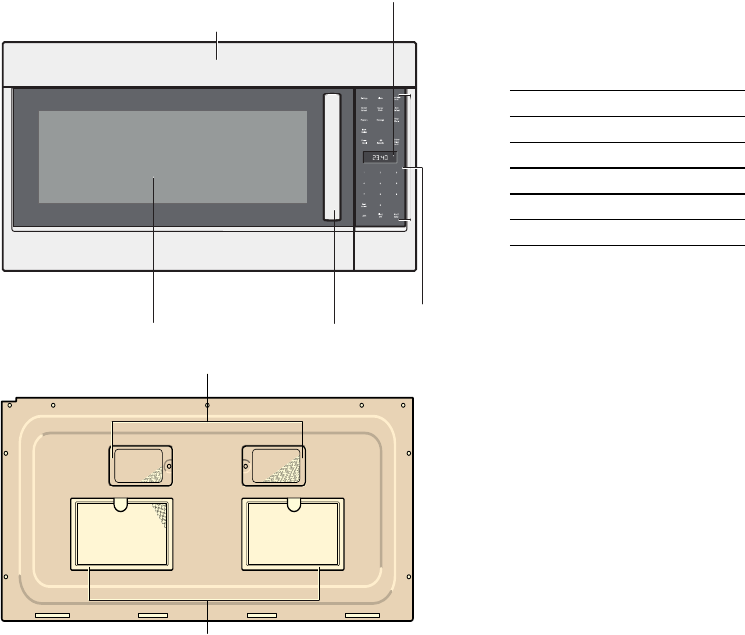
PART NAMES
Front view
Bottom view
1Top vent grill
2Display
3Control panel
4Door handle
5Window
6Surface lights
7Ventilation filters
Cooling Fan
The cooling fan runs during all cooking modes. The fan
can be heard when it is running, and warm air may be
felt as it is released from the oven vent. The fan may also
run after the oven is off.
Oven Vent
The oven vent is located at the top of the unit. Warm air
may be released from the vent before, during and after
cooking. It is normal to see steam escaping from the
vent, and condensation may collect in this area. This
area may be warm when the oven is in use. Do not block
the vent, since it is important for air circulation.
8
Convection Fan
The convection fan operates
modes.
mode, the
opened.
during all convection
When the oven is operating
in a convection
fan turns off automatically
when the door is
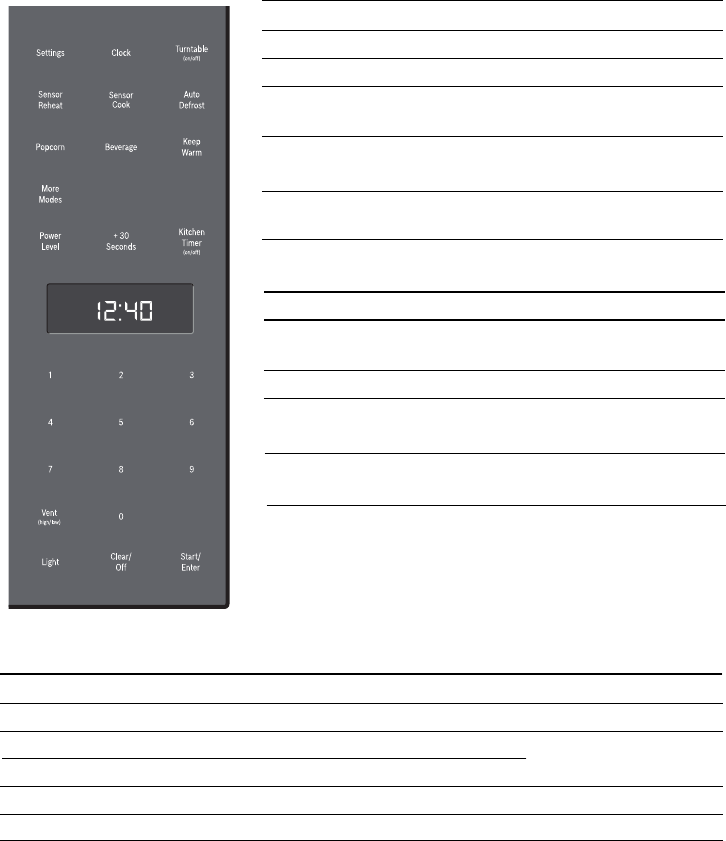
Control panel
Settings Change basic settings
Clock Set time of day
Turntable
(on/off) Switches turntable on or off
Sensor Reheat Reheat food with automatic
Sensor Cook Cook food with automatic
Auto Defrost Defrost food with automatic
settings
settings
settings
Popcorn Select popcorn bag size
Beverage Heat beverages, select
Keep Warm Set Keep Warm feature
More Modes Enter more modes for
cooking
Power Level Set power level for microwave
tion
+30 Seconds Add 30 seconds to microwave
Kitchen Timer Set kitchen timer
0 - 9 Use the number keys to enter cus-tomized values
Vent (high/low) Turn kitchen ventilation feature on/off
Light Turn surface light on/off
Clear/Off Clear entered value/turn appliance off
Start/Enter Confirm input, start operation
size
convenience
beverage
opera
timer
Press button Function
Press button Function
9

10 power levels are available.
Level
10
9
8
7
6
5
4
3
2
1
Power
Display
PL10
PL9
PL8
PL7
PL6
PL5
PL4
PL3
PL2
PL1
100%
90%
80%
70%
60%
50%
40%
30%
20%
10%
1) "00:00" to remind you
to
2) Press the number keys and enter the correct time. For example, time is 10:12 now,
please press "1,0,1,2" in turn.
3) Press " "
In waiting state, press " " once.
time.
The clock can be set in 12-hour mode.
or "
"
and 99 seconds)
" button to cnfirm the clock.
or
counting down.
1) ress the number keys to set the cooking time.(The maximum cooking time
and 99 seconds)
2) Press "
" repeatedly to adjust the power level. The default power is PL10.
3) Press " " to start microwave cooking.
1) In waiting state, press " " button to cook with 100% power level for 30
Each press on the same button can increase 30 seconds. The maximum
99 minutes and 59 seconds.
2) During press " " to
cooking time is
Each press on the same button can increase 30 seconds.
99 minutes and 59 seconds.
cooking time is
will blink in the display
input the
once, "00:00" will blink in the display.
In waiting state, p
is 99 minutes
cooking process(except defrost or keep warm),
increase the cooking time.
maximum
Clock
Start/Enter Clock
Kitchen Timer
" " to confirm setting. The kitchen time will start
Start/Enter Kitchen Timer
Power Level
Start/Enter
+30 Seconds
+30 Seconds
10
1 . Power Level
Operation
2 . Clock
3 . Kitchen Timer
4 . Time Cook
5 . Add Cooking Time (+30 Seconds)
1) Press "
2) Press the number keys and enter the timer time.(The maximum cooking time is 99 minutes
3) Press " "
seconds.
The

1) Press " " once, "dEF1" will blink in the display.
" repeatedly to choose the desired function. And "dEF1", "dEF2"
"dEF3" will display in turn.
2) Press "
3) Press " " to confirm the function. The screen will display "0.0 lb".
4) Press the number keys to set the weight of the food.
" to start defrosting.
5) Press "
Note: Defrosting consists of 3 stages. When the first one and last one stage is finished, 5 beeps
Auto Defrost
Auto Defrost
Start/Enter
Start/Enter
11
Auto Defrost programs
Program Food Weight range
Ground meat 0.5 - 3 lbs
Meat pieces
(steaks, chops) 0.5 - 3 lbs
Poultry pieces 0.5 - 3 lbs
dEF3
dEF2
dEF1
6. Auto Defrost
, "00:00"
will blink in the display.
keeping warm.
" repeatedly until the number you wish appears in the display.
"1"SET: approximate 1.2 ounces
2"SET: approximate 2.5 ounces
3"SET: approximate 3.5 ounces
For example, press " " once , "1.2" appears in the LED.
2) Press" " to cook.
"
Start/Enter
Keep Warm
Popcorn
Popcorn
Start/Enter
7. Keep Warm
8. Popcorn
1) Press "
2) Press the number keys to set the time of keeping warm.(The maximum time is 60 minutes).
3) Press " " to confirm setting. The oven will start
1) Press "
will sound.

" repeatedly until the number you wish appears in the display.
"1"SET: approximate 0.5 cup (about 8 ounces)
"2"SET: approximate 1.0 cup (aboutn 16 ounces)
"3"SET: approximate 1.5 cups (about 24 ounces)
For example, press " " once , "0.5" appears in the display.
2) Press "
"4"SET: approximate 2.0 cups (about 32 ounces)
" to cook.
Beverage
Beverage
Start/Enter
12
, "
is blinking in the screen."Sr-1"
" repeatedly until the menu you wish appears in the display.
And "Sr-1", "Sr-2" will display in turn.
Sensor Reheat programs
Program
no. Food Quantity
Dinner plate 8
Casserole, pasta 2 to 4 cups
Sr-1
Sr-2
Sensor Reheat
Sensor Reheat
Start/Enter
9. Beverage
10. Sensor Reheat
1) Press "
1) Press "
2) Press "
3) Press " " to start sensor reheat mode. The appliance starts sensing.
, " is blinking in the screen.
Sc-1"
" repeatedly until the menu you wish appears in the display.
And "Sc-1", "Sc-2", "Sc-3"..."Sc-9" will display in turn.
"
Sensor Cook
Sensor Cook
11. Sensor Cook
1) Press "
2) Press "
The microwave is operating during sensing. When sensing is complete, two short beeps will
sound and the calculated cook time will start to count down.
Note: Do not open the door during the sensing process, or the program will be cancelled.
Start/Enter
3) Press " " to start sensor cook mode. The appliance starts sensing.
The microwave is operating during sensing. When sensing is complete, two short beeps will
sound and the calculated cook time will start to count down.
Note: Do not open the door during the sensing process, or the program will be cancelled.
16 Ozto

Food
Baked Potato 1 - 4 potatoes
Sweet Potato
Fresh Vege
table 8 - 24 oz
Frozen Vege
table 8 - 24 oz
Ground Meat
Fish/Seafood
Brown Rice
White Rice
Frozen Entrees
1 - 4 potatoes
8 - 24 oz
8 - 20 oz
Quantity
Display
Sc-1
Sc-2
Sc-3
Sc-4
Sc-5
Sc-6
Sc-7
Sc-8
Sc-9
Sensor Cook programs
13
, " is blinking in the screen.1-5 "
" repeatedly until the menu you wish appears in the display.
And " 1", " 2" ..."5" will display in turn.
Press " " .
For modes 1 to 4: press number keys to enter the desired weight category;
For modes 5(time defrost): "00:00" is blinking , then press number keys to
3)
2) Press "
Note: Time Defrost consists of 2 stages. When one stage is finished, 5 beeps will sound.
enter the desired defrost time.
"
More Modes
More Modes
Start/Enter
Start/Enter
12. More Modes
1) Press "
4)Press " " to start operation .
1 - 2 cups
1 - 2 cups
8 - 24 oz
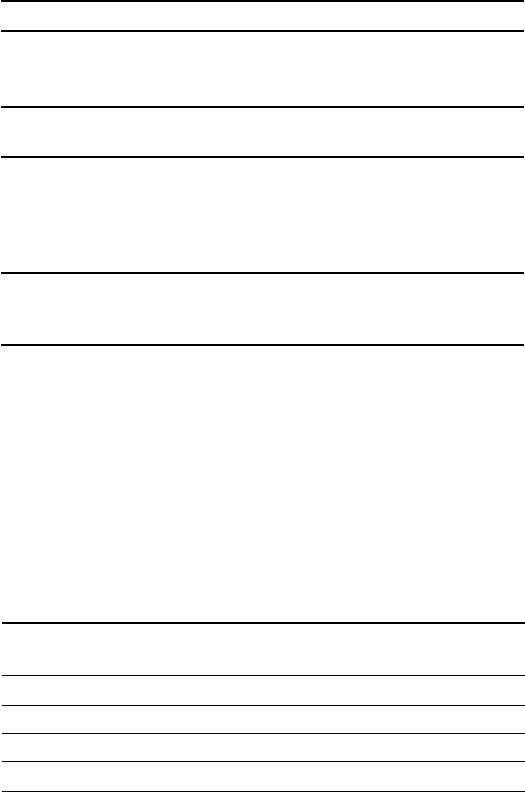
Available modes
Mode no. Name Input
1Melt butter 1 = 2 tablespoons
2 = ] cup
3 = ^ cup
2Melt chocolate 1 = 1 cup
2 = 2 cups
3Soften ice cream 1 = 4 oz.
2 = 8 oz.
3 = 16 oz.
4 = 32oz.
5 = 48 oz.
4Soften cream cheese 1 = 3 oz.
2 = 6 oz.
3 = 8 oz.
5Time defrost Enter defrost time
14
The Vent feature moves steam and other cooking vapors from the cooking
microwave oven.
You can set four different vent speeds.
Set the vent feature by pressing" " repeatedly. The ventilation
¾ will light up on the display.
Vent level
Display
4 (high)
3
2
1 (low)
OFF
surface of the range below the
13 .Operating the Ventilation Fan
1 LO
3
2
4 HI
OFF
Vent (high/low)
symbol

The appliance is equipped with a cooking surface light, to light the surface
With the" " button you can set two brightness
Brightness
High
Low
Off
underneath the appliance.
levels.
14 .Turning the Surface Light on/off
Display
LO
HI
OFF
Light
15
For best cooking results, leave the turntable on. It can be turned off for
To turn the turntable off, press" " once.
The Á symbol and"OFF" lights up briefly. Press the
Á symbol and"ON"
lights up briefly.
large dishes.
the turntable on. The
15 .Turning the turntable on / off
button again to turn
Turntable (on/off)
To activate the panel lock:
for more than 3 seconds. The ¿ symbol lights
sounds.
To deactivate the panel lock:
for more than 3 seconds. The
¿ symbol
unlocked.
16 .Panel Lock
Press and hold" "
Press and hold " "
up in the display, a double beep
disappears from the display. The panel is
Clear/Off
Clear/Off

Example: Turn clock display on/off.
twice.
1 to turn the clock display on, 2 to turn
Start/Enter .
Note: You can only change one setting at a time. To change another
menu first and begin from step 1.
setting,
you have to exit the settings
Display Function
Settings button
1 - on
2 - off
once
Clock display in stand-by
mode on/off
1 - on
2 - off
twice
Press
Snd
Clo
Button sounds on/off
Clo and OFF or On alternate in the display.
press
Settings
17 .Settings
16
the
clock display off.
1)
Press" "
Press the number button
Press " "
2)
3)
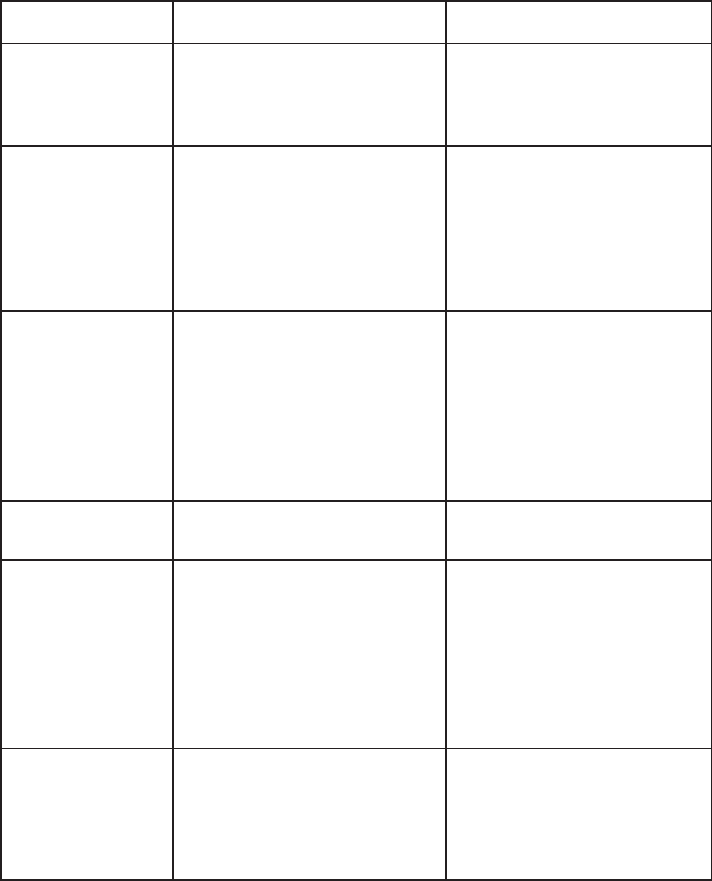
lation ports are not restricted.d. Use correct cooking time, power level.Improper defrostinga. Materials to be avoided in microwave oven were used.b. Cooking time, power level is not suitable.c. Food is not turned or stirred.a. Use microwave-safe cookware only.b. Use correct cooking time, power level.c. Turn or stir food.MAINTENANCE
Troubleshooting
Check your problem by using the chart below and try the solutions for each problem. If the
microwave oven still does not work properly, contact the nearest authorized service center.
TROUBLE
Oven will not start
POSSIBLE CAUSE POSSIBLE REMEDY
a. Electrical cord for oven is
not plugged in.
b. Door is open.
c. Wrong operation is set.
a. Plug into the outlet.
b. Close the door and try
again.
c. Check instructions.
Arcing or sparking
a. Materials to be avoided in
microwave oven were
used.
b. The oven is operated when
empty.
c. Spilled food remains in the
cavity.
a. Use microwave-safe
cookware only.
b. Do not operate with oven
empty.
c. Clean cavity with wet towel.
Unevenly cooked
foods
a. Materials to be avoided in
microwave oven were
used.
b. Food is not defrosted
completely.
c. Cooking time, power level
is not suitble.
d. Food is not turned or stirred.
a. Use microwave-safe
cookware only.
b. Completely defrost food.
c. Use correct cooking time,
power level.
d. Turn or stir food.
Overcooked foods Cooking time, power level is
not suitable. Use correct cooking time,
power level.
Undercooked foods
a. Materials to be avoided in
microwave oven were used.
b. Food is not defrosted
completely.
c. Oven ventilation ports are
restricted.
d. Cooking time, power level is
not suitable.
a. Use microwave-safe
cookware only.
b. Completely defrost food.
c. Check to see that oven venti-
lation ports are not restricted.
d. Use correct cooking time,
power level.
Improper defrosting
a. Materials to be avoided in
microwave oven were used.
b. Cooking time, power level is
not suitable.
c. Food is not turned or stirred.
a. Use microwave-safe
cookware only.
b. Use correct cooking time,
power level.
c. Turn or stir food.
MAINTENANCE
17